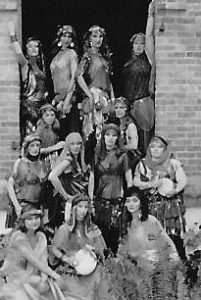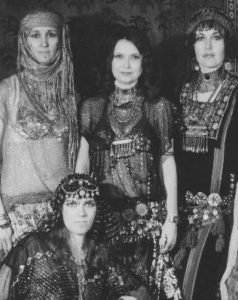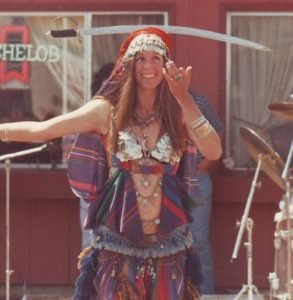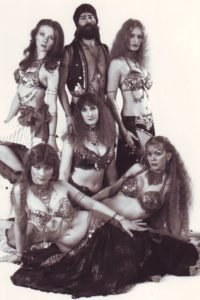Examining Dance Forms to Define What You Do
Recently, a dancer posted a video on YouTube labeled “Tribal Versus Cabaret Bellydance” in which she tried to explain the differences between “tribal” dance and “cabaret”. The errors in the video were disturbing, because they will be seen by many students who really don’t know they are seeing a less-than-accurate video.
First, “tribal” is a bit misleading, since tribal dance itself is not one thing.
In the 1970s, Tribal Dance meant a particular style that was inspired by Jamila Salimpour’s Bal Anat performing group- a combination of bellydance movements, a particular costuming approach, and a theatrical presentation of tribal “flavor” without always being authentic.
Later, Carolina Nerricio took a different approach altogether to the “tribal” concept and created what is called American Tribal Style, which is dramatically different, and easily seen to be different from, the previous Tribal Dance. While it is still possible to find dancers presenting in the 1970s tribal Dance style, it is more common now to find ATS dancers, or dance forms that clearly were inspired by, or derived from, ATS. In the video I mentioned, the dancer is presenting ATS dance.
Second, “cabaret” is an inaccurate term. Here’s why:
The term cabaret is problematic with many dancers, because the term has a negative connotation for some. However, the reason the term was adapted to and identified with American style bellydance was because the original term simply meant “a restaurant providing food, drink, music, a dance floor, and often a floor show; a café that serves food and drink and offers entertainment often of an improvisatory, satirical, and topical nature”. Because most professional American bellydance took place in dinner clubs or restaurants in the earlier days, , American bellydance aficionados and dancers started referring to themselves as the term “American Cabaret Bellydance”.
But it got trickier than that, too, since the term “American cabaret” also referred to the type of costuming worn. At the time this term developed, there were dancers performing in the more covered “1970s tribal” costuming, as distinguished from the more common bellydance costume- the two-piece bedlah, or bra and belt with skirt, or sometimes, the “beladi dress”. So you might hear a dancer say “I’m wearing cabaret” or “I’m wearing tribal”. This was not, I add, a national trend, but was focused more in the western United States. (See photos at end of article)
To further complicate things, the term cabaret as used in this video is ignoring a few more facts:
1) There is raks sharqi (and the other native styles of bellydance- Egyptian, Turkish, Iraqi, and so on) which is a relatively modern dance form that has three recognized eras: traditional, classic and modern.
2) Then, we have American Bellydance, also called American Danse Orientale, American Cabaret style, and its own range of styles depending on where the dancer is- east coast, west coast, north, south, etc.
3) Then, we have 1970s Fusion, also called Fusion Bellydance, which developed as a blend of raks sharqi and American Bellydance, and consisted of the combination of two or more RELATED dance forms, and this is where dancers began to move away from bellydance as it had been and into what could be called a new dance form.
4) We then have ATS, or American Tribal Style, which inspired multiple different styles. ATS developed around an improv group dance approach, the dancers following visual cues, as opposed to the Tribal and Fusion group dances, which were choreographed to adhere to an intent (solos remained improv, unchoreographed).
5) After Fusion and ATS, a plethora of new dance styles derived from these new forms were developed, until we now have much confusion over what exactly the dancer is really doing. For some, the term Synthesized Dance was used, because it represented a blend of two or more UNRELATED dance forms to create a new whole, others used the terms Tribal Fusion, Industrial Fusion, Urban Tribal or Urban Fusion and so on…
6) And here’s the one that upsets people the most: if we look at dance characteristics, or identifying markers, in dance, we have to be able to admit that all these new forms after American bellydance are not bellydance. It can even be argued that some American Bellydance is not bellydance, if we accept that dance forms have characteristics- and that is hardly a debate, since we have used dance characteristics to define dance forms for many, many decades. What these new dance forms are is unique, amazing, inspiring new dance forms that deserve their own niche in the history and culture of dance.
This is the problem with the video I mentioned: it attempts to define an ever-widening group of dance forms in such a simplistic way, such a limited observation, that it fails on almost every level. I’ve spent a few decades examining the various dance forms in this genre, and find it kind of sad that, despite much GOOD info out there, things like this video are being presented, seen and believed. We owe better to those coming into the dance community.
So how do we start?
One of the primary ways to define a dance form are to examine its recognizable characteristics– the things that we all expect when we see a person performing (or teaching) that dance form. In other words, what makes a dance form that dance form? When looking at folk/folkloric dance, bellydance and offshoots, the characteristics include, but not limited to:
- How movement is used in the dance form; the technical execution of a movement and how it is used in the dance form. Many of these related forms, or inspired-by forms, share movements including the direction of the wrists, the use of articulated movements, etc; additionally, there are some movements that are not shared, or are executed in a slightly different way.
- What music is used and why. This is quite important. Music is often a very defining element in a dance form.
- The dancers approach to the music and her relationship with it. In raks sharqi, in bellydance, the dancer’s task is to, as Deborah Majewski put it “become the physical manifestation of the music”. Or, as dancer Sadia stated in an article: “… dancers portrayed the music instead of posturing, showing off, or trying to be sexy. Each one communicated the story of the Music, not the story of her Beauty, her Fame, or her Newest Shocking Costume. Each dancer had a unique approach in creating her own interpretation….And if a dancer had amazing skills, her dance was never about showing off her Greatest Moves, whether they fit or not. It was always about translating the music with appropriate movements…. when I tell dancers [their] movements don’t articulate the music, they say something about a “New Style”. Well, I can assure you there is only one “Style”. That is the style of the music to which you are dancing. If you want to do movements and use technique that are not of that style of music, then change your music selection. If you want to perform a classical piece, you have to use classic movement vocabulary. Belly Dance is not a mix-and-match smorgasbord, even though many people try to make it that way. Bellydance is about the music; in many western style, it is about the dancer- quite a difference.
- The intent or function of the dance form, including how it is presented both in a solo and in a group.
- The use of the stage. Some forms are more “vertical”, others more “horizontal”.
- What clothing is typically worn. This is where there is a lot of confusion, because the newer forms have sometimes adopted the typical “bellydance costume” (beaded bra and belt with skirt; beladi dress with beaded or sparkling hip wrap, and variations in between), whereas, IMO, they do better with an entirely new approach that better reflects their newer form. For example, in the original Tribal style, costuming was multi-layered, but still reflected a somewhat “imaginary” Middle Eastern/Near Eastern flavor with tribal jewelry and coined bras and belts (sometimes with tassels); in ATS, the midriff is usually bare and there are costuming elements from several global regions as well as being heavily tasseled; in the Synthesized forms, costuming can be all over the clothing map, though I see a tendency to reflect a lot of the ATS approach.
- The dancer’s relationship to the audience and vice versa. It’s important to remember that the original audiences for bellydance understood the music and lyrics used; they would often sing along with parts of the song, and they knew the meaning of the lyrics and how it related to themselves as members of a community. And while this was true in the older era of this dance in the US and elsewhere, the modern dancer often finds herself performing to an audience that has no clue what the music is, what the lyrics are, or what they mean, and there is no shared community to help define/experience the dancer or the music. Another change is that much of the dancing in the past took place in clubs and restaurants frequented by members of the community who understood the music, whereas for many dancers today, the performance opportunities are, for most dancers, limited to haflas, “novelty” public performances and the infrequent dance show put on by other dancers.
- Cultural or historical back story; the “essence’ of the dance, and so on. All folkloric or folk dance, all national dances, have a “backstory”, a history of development. In each culture, how the movement is translated, how the movement is used with the music, is unique. In many cases, the function of a dance is specific to an event, a celebration, an expression of a people…..this is why understanding essence is important.
- In addition, we could even include, how is this dance form best taught, what is the methodology that works when teaching this form? Western dance forms related to bellydance have more often developed a methodology that is precise and based on a hierarchal system of teaching levels, and reaching marked measured levels of mastery within the form. Eastern forms often take a completely different approach, marked by a Beginning level and then moving into a continual, level of individualized mastery more grounded in the relationship to the music.
To me, these are quite definitive and make each dance form what it is, and makes them recognizable. This is why I see a difference between raks sharqi (and it’s native forms with stylized differences), American Bellydance (also referred to as American Danse Orientale, AmCab, and several other labels); 1970s Tribal (pre-ATS and its progeny), 1970s Fusion (a blend of two related dance forms), ATS, and what I call Synthesized Dance (a blend of two or more UNrelated dance forms), also called Tribal Fusion, and several other labels, Techno-Fusion (also referred to by some as Industrial Fusion), and so on, ad infinitum.
If a person watches many different dancers doing different styles or forms, and applies these defining characteristics, you can see a pattern start to develop… just something to think about.

1970s Tribal Costumes

1970s Tribal

1970s Tribal Costume

Bedlah-based costumes, sometimes called “Cabaret Bellydance” costumes

American Bellydance Costume
© February 2018 Prima Beladi

